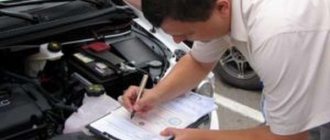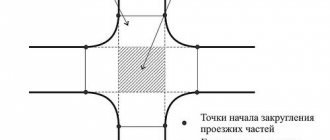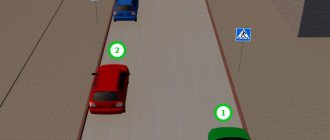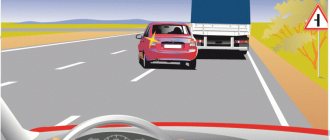Relaxing on the shore of a reservoir is a popular entertainment. However, not everywhere you can simply drive up by car and stand on the shore: if the parking area turns out to be a water protection zone, the culprit will face punishment. Let's figure out what this zone is, why stopping is prohibited in this environmental protection zone, where you can park near the river, and who and what fine can be issued for illegal parking in the prohibited zone.
What is a water protection zone?
The definition of a water protection zone is given by Art. 65 VK RF. According to its norms, this term refers to the territory that is adjacent to the boundaries of the reservoir , and in which a special regime of activity applies. The purpose of this regime is to prevent:
- water pollution;
- depletion of water sources;
- disruption of habitat for aquatic plants and animals.
The sign is installed on a white pole near a pond.
The width of the water protection zone varies depending on the status of the reservoir and ranges from 30 to 500 m . The exact minimum size established for rivers, reservoirs, lakes and seas can be found in the VK of the Russian Federation, but there is one exception - Baikal. A special status has been established for it, and the width of the security zone is regulated by Art. 3 Federal Law “On the protection of Lake Baikal”.
There are bodies of water for which a protection zone is not established. These are rivers and streams taken into sewers. If normal regime were in effect in these facilities, life in many cities would be extremely difficult.
Difference from coastal protection strip
The water protection zone also includes a protective strip of water bodies. This is the part of the zone that is directly adjacent to the shoreline of the reservoir. Sometimes both of these concepts coincide: for example, for streams and rivers with a length from source to mouth of less than 10 km, the water protection zone and the protective strip are one and the same.
The main difference between a water protection zone and a protective strip is the greater severity of the regime. While it is still possible to carry out at least some kind of economic activity in the water protection zone, practically nothing is allowed in the protective strip - neither plowing, nor dumping soil, nor grazing livestock.
Rules for sanitary protection zones
If a reservoir serves as a source of water supply for the population, measures to protect it are strengthened many times over.
There is a sanitary protection zone around it, in which three zones are distinguished (according to the degree of severity of the regime): A) The first zone (the strictest) is the territory where the water intake system and water supply facilities are located. Its minimum width is:
- from 30 to 150 m to the water intake (for a groundwater source),
- from 100 to 200 m (for water intake from the surface of the source).
Within the boundaries of the first zone, swimming, washing clothes, and draining wastewater (including from water transport) is prohibited.
B) The second and third belts serve to prevent contamination of the water source.
Depending on the climatic and geological characteristics of the area, their boundaries can be established within the following framework:
- at least 100 -750 m to the source (2nd zone),
- 3 - 5 km to the watershed line (lateral borders of the 3rd belt).
Within the second zone, swimming, fishing, and water sports are permitted only in specially designated places, subject to all hygienic requirements for water protection.
That is, it is prohibited to dump wastewater, garbage, wash vehicles, etc. into the source. The prohibitions of the third zone concern mainly economic activities (mining, storing fuel and lubricants, etc. is not allowed).
Fines for violating the rules of sanitary protection zones have now become much higher and depend on the zone in which the offense was committed:
- in the first belt - from 10 to 20 thousand rubles,
- in the second belt - from 5 to 10 thousand rubles,
- in the third zone - from 3 to 5 thousand rubles.
Is it possible to drive up to the river by car and is parking allowed?
Regarding transport, Art. 65 of the RF Military Code directly establishes the following restriction: in the water protection zone, and especially on the coastal protective strip, you can neither stop nor drive through .
The only exception provided for in paragraphs. 4 hours 15 tbsp. 65 of the Criminal Code of the Russian Federation - these are cases when vehicles are moving and standing either on roads or on specially equipped areas with hard surfaces. The logic of this rule is obvious:
- A heavy machine standing on loose soil can cause the soil to gradually slide with its weight. This, in turn, will lead to crushing, silting and waterlogging of the reservoir.
- A vehicle, even one that meets environmental standards for transport, is a source of pollution.
How many meters away can you park your car from the river? Distance to the reservoir
If there are no signs nearby, then you can comply with the law if you are guided by the following table:
| Type of reservoir | Zone width, m |
| Streams and rivers less than 10 km long | 50 |
| Rivers from 10 to 50 km | 100 |
| Rivers more than 50 km long | 200 |
| Lakes and reservoirs with an area of more than 0.5 square meters. km | 50 |
| Flowing reservoirs on streams and rivers | Like a stream or river on which a dam is built |
| Seas | 500 |
| Channels | By width of the right of way |
| Lake Baikal | In accordance with decisions of local authorities, but not less than 50 m |
In specific examples it will look like this:
- Residents of Voronezh enjoy relaxing on the sandy beaches of the Usmanka River (the lower reaches of the Usman River). According to the map, the length of this river is 151 km, which means that the car must be parked no closer than 200 m.
- A resident of Stary Oskol decided to swim in the Ublya River, which flows near the city. The length of this river is 51 km, which means you can park no closer than 100 m from the shoreline.
- The length of the Volga River is 3.53 km, and the water protection zone is 50 meters.
The width of the protection zone and its border are legally different things. Therefore, you must first focus on the warning signs near the shores of the reservoir. But in any case, being at a distance from the shore less than indicated in the table will be an offense.
If we allow motorists to park 50 meters from the water, what will this lead to?
Guests
Mikhail Kulik lawyer, specialist in the field of legal regulation of shipping
Oksana Galkevich:
What if this house, a vegetable garden, is somewhere on the banks of a beautiful Russian river? Or some Bashkir, Tatar...
Ivan Knyazev:
And it’s not bad near the sea either.
Oksana Galkevich:
Oh, not bad at all. This is what we want to talk about, friends. By the way, now it is very important, please note, to add your opinion to the piggy bank. Get involved as actively as possible in the discussion of the next topic. The State Duma is currently collecting feedback on one, well, controversial, so to speak, bill. The fact is that there is such a proposal. Allow motorists to park closer to the water.
Ivan Knyazev:
They went in so smoothly.
Oksana Galkevich:
Yes. Now, as you know, you can drive up to a distance of 200 m. But in the draft amendments to the Water Code we are now talking about 50 m. That is, from 200 to 50. They say that this will not cause any particular harm to nature, but tens of millions of car tourists (by the way, I am also one of them and love this business very much), and so, for such people who travel around the country by car, it will be noticeably more pleasant to relax in the fresh air, closer to somewhere some body of water. We drove up to the water and set up a tent there. Close, convenient, everyone is happy, everyone is wonderful. And one more argument. Like, we already have a lot of roads built in close proximity to the water, so people drive on them? They are driving. We also have campsites here and there in the water protection zone. By the way, according to the law, you can stop at specially equipped sites. Within these 50 m and even closer. But the question is precisely this: won’t the current water protection zones, which are still very water-protective, begin to be actively developed, actively used somehow for various needs? Let's talk about this now. Please express your opinion live. We are looking forward to your calls and messages. And by the way, let's start a short poll. The question is: reduce the water protection zone? Send your answers “yes” or “no” to our SMS number. In the meantime, we will connect...
Ivan Knyazev:
5445. Yes, for now we’ll include our expert in the conversation. This is Mikhail Kulik, lawyer, specialist in the field of legal regulation of shipping. Hello, Mikhail Fedorovich.
Oksana Galkevich:
Mikhail Fedorovich, hello. So, we see you, the audience sees you too.
Ivan Knyazev:
But for some reason we don’t hear it.
Mikhail Kulik:
Good afternoon, good afternoon. You speak - I am silent.
Oksana Galkevich:
No, we know that you speak well too.
Ivan Knyazev:
Now you.
Oksana Galkevich:
And you, by the way, are also a famous not only automobile, but also, how to say, water tourist too.
Mikhail Kulik:
Boatmaster. Boatmaster of a small boat.
Oksana Galkevich:
Boatmaster, yes. That's right. Boatmaster. Well, tell me, Mikhail Fedorovich, how do you feel about this initiative? Since there is a collection of opinions, a collection of reviews in the State Duma. What kind of feedback would you leave?
Mikhail Kulik:
Oksana, I’ll clarify a little. It is no longer a collection of opinions, i.e. there is no public discussion going on. The draft has been submitted for consideration by the State Duma in the first reading. This is planned for the March session of the State Duma. That is, as I understand it, legislators are planning to make life easier for you and me, for you as a car tourist, for me as a water tourist, by the opening of the tourist and navigation season. If I may, I will say that this applies not only to tourists, vacationers and travelers by car, but rather, even primarily, to navigators of small vessels, which include fishermen.
Oksana Galkevich:
We just suspect that this is not only about motorists. That's why we want to talk to you. Come on, tell us who else it concerns. And, most importantly, how it will affect you.
Mikhail Kulik:
I'll definitely tell you. So. Firstly, this will, of course, affect those who arrive by car in order to relax and spend time near the water. As everyone knows, water in the Russian Federation is the property of the entire people, forgive me for such lofty words.
Oksana Galkevich:
But they are correct.
Mikhail Kulik:
And restricting access to water is illegal. This measure with the establishment of a 200-meter water protection zone, of course, has a positive meaning, since water bodies need to be protected. But at the same time, the ban that now exists in Article 65 of the Water Code, exactly the one we are talking about, is in fact not just a ban, but a ban that cannot be overcome. We all know of cases, those who are constantly on the water, of ambushes by inspectors catching those who have even run over a wheel...
Oksana Galkevich:
That is, I understand correctly that there is some kind of contradiction, right? On the one hand, this should be in the public domain and access cannot be limited. On the other hand, you can’t come closer and run over it with a wheel. There is a contradiction in the law.
Mikhail Kulik:
Quite fair. The same Water Code says that any citizen of the Russian Federation has the right to use all water resources without restrictions, with the exception of those methods of use that harm the ecology and environment and other citizens. In addition, it is expressly stated that every citizen has the right to travel on water bodies in federal, regional and municipal ownership without restrictions on a small vessel. During periods when this is permitted. Well, actually, it is not allowed only during the period of spawning ban, when we allow biological resources (this is what is called in the law), i.e. fish, to calmly spawn and produce offspring. What I wanted to say: I don’t know how many car tourists there are, but today there are 1 million 500 thousand small boats registered in Russia. What's this? This is a non-commercial use boat, up to 20 m in size. People travel on them, spend time, relax and teach their children to live a real life in nature, and not on smartphones with different games like Minecraft.
Oksana Galkevich:
Let's call you "boat lovers." We are car enthusiasts, and you are boat enthusiasts.
Ivan Knyazev:
And then they get caught and fined for this?
Mikhail Kulik:
They are fined and more...
Ivan Knyazev:
Mikhail Fedorovich, do they fine you heavily? I just wanted to understand those who violate. The Kaluga region writes that this is very bad, because you can’t go fishing, you can’t relax, you can’t get there by car. Fishermen in Kaluga are complaining.
Mikhail Kulik:
What I wanted to say. From 3.5 to 5 thousand rubles. fine. And so, having arrived somewhere near Astrakhan for fishing (where many people from all over Russia come at certain periods), imagine - having arrived for a week and weekly, in addition to your main expenses, you incur the cost of paying fines. There will be repetition and the penalty will be bigger and bigger and bigger each time.
Ivan Knyazev:
And at the same time, I know, I was in Astrakhan, there really are a lot of rivers and everything else in the floodplain of the Volga, you can’t park there, and you can’t park your car anywhere.
Mikhail Kulik:
Absolutely right. That is, I’ll plunge a little into my legal element and say. What does Article 65 sound like now? I won't read it all out. A water protection zone is an area that is adjacent to the coastline and has a certain size. On average, this is 200 m. There are reservoirs of a different category, where there is less, and there are where there is more. Well, in general, 200 m. And in this water protection zone, in accordance with paragraph 15 of this article, the movement and parking of vehicles, except for cars and other special vehicles, is prohibited. That is, of course, emergency services, etc.
Ivan Knyazev:
I see, yes. And there at the mouth of the Volga there are so many branches that, it seems to me, between one body of water and another - there’s even less than 200 m, there’s less than 100 m. You can roughly drive.
Mikhail Kulik:
Absolutely right. Thus, the mouth is completely blocked for us. And now legislators are proposing that the Orenburg Regional Duma, the legislative assembly, came up with such an initiative...
Oksana Galkevich:
Yes.
Mikhail Kulik:
...and what do they offer? They propose not to allow, but to expand exceptions. That is, in the new edition the article will read like this: “The movement and parking of vehicles, except for special ones, are prohibited in the water protection zone, and also...” This “and also” is us, i.e. who we are talking about now. “...as well as passenger vehicles, motorcycles, mopeds that move and park for the purposes of citizens’ recreation, tourism, hunting, fishing, and citizens’ physical education and sports.” But, you know, what a thing (sorry, I'll finish) arises. We were allowed to enter, but not allowed to launch the boat.
Ivan Knyazev:
Yes, then why go.
Oksana Galkevich:
It's clear. Well, maybe in the next amendments, Mikhail Fedorovich, everything about you will also be spelled out there, as it should be. For now, only car enthusiasts... May be so. Thank you, Mikhail Fedorovich.
Ivan Knyazev:
Thank you.
Oksana Galkevich:
A lawyer, a specialist in the field of legal regulation of shipping, was in touch with us, Mikhail Kulik. We have several calls. The first is Elena from Khabarovsk. Elena, hello.
Ivan Knyazev:
Hello, Elena.
Oksana Galkevich:
What do you think? Is it necessary to reduce the water protection zone? Elena?
Viewer:
No no need.
Oksana Galkevich:
So. Why?
Viewer:
We live in a village. And we have a river nearby. So if they cut back, there will be deforestation. And when deforestation occurs, rivers become shallow and disappear automatically. And there are villages nearby that need rivers, well, there is fishing, etc., they die.
Oksana Galkevich:
That is, you think that the harm that can be caused...
Ivan Knyazev:
There will be more…
Oksana Galkevich:
...more than some benefit?
Viewer:
Yes Yes Yes. Because both the topography of the river and its structure are changing. They are getting shallow. And they dry.
Oksana Galkevich:
Thank you.
Ivan Knyazev:
Thank you. But, by the way, there are a lot, Oksana, SMS from those people who write...
Oksana Galkevich:
Well, what do they write?
Ivan Knyazev:
...here is the Vladimir region: “No. The water protection zone, on the contrary, needs to be enlarged and compliance with these legal norms must be monitored even more strictly.”
Oksana Galkevich:
Well, different opinions. Some people say that we just need to create paid parking lots, where cleanliness and order will be strictly observed, and some small fee will be charged.
Ivan Knyazev:
Let's find out the results of our survey.
Oksana Galkevich:
And these are the results of the survey. 29% believe that it is necessary to reduce the water protection zone, 71% believe that... no, already 72% even, yes, everything is changing in real time.
Ivan Knyazev:
72%. That is, they are still voting.
Oksana Galkevich:
Go ahead.
Ivan Knyazev:
Thank you, dear friends, let's move on.
Fine for entry and parking (parking) near a reservoir
A driver who enters a water protection zone and parks his car there will have to face the consequences provided for in Part 1 of Art. 8.42 Code of Administrative Offenses of the Russian Federation. It provides for only one type of punishment - a fine. Its size will be:
- For ordinary citizens – from 3 to 4.5 thousand rubles.
- For officials – already from 8 to 12 thousand.
- For legal entities (for example, for a company that organized parking in the wrong place) - from 200 to 400 thousand rubles.
From a formal point of view, even a bicycle is considered a vehicle. But in practice, cyclists are usually not fined. Hunters who cross forest streams in vehicles are also rarely brought to justice. Finally, fines are usually not imposed in cases where the offense is minor: for example, a fisherman brought a motor boat on a car trailer, unloaded it onto the water and immediately drove the car outside the water protection zone.
If you believe that you have been fined illegally, contact our auto lawyer and get a free consultation. And be sure to read how to appeal a traffic police fine.
Russia introduces fines for driving closer than 200 meters from a body of water
The Russian government has introduced a controversial bill on fines for driving near the river, closer than 200 meters. Officials are confident that driving at such close distances is too harmful to the water and fauna.
Will there be a fine for driving closer than 200 meters to the river and lake?
Representatives of the State Duma of the Russian Federation supported the law regarding a fine for moving vehicles closer than 200 meters from a river, lake or reservoir.
In accordance with the document, it is necessary to establish a coastal zone near water bodies in order to have a beneficial effect on the living conditions and reproduction of important biological resources. If a person drives his vehicle, including a bicycle, closer than 200 meters, he can receive a fine of several thousand rubles.
The draft law has attracted quite a few opponents who want it to be repealed. What is most infuriating is that not only pests, but also ordinary Russians who live in rural areas can face a fine.
As a rule, in such places there is no asphalt road, so you have to be content with a dirt road that is too close to the rivers. It is worth noting that the deputies supported the law during the first reading, but in the future they plan to finalize the document.
Oleg Shein, who is one of the State Duma deputies, said that the document needs to be improved. There are many people who do not go fishing, but live in that area, and they do not have a detour to get home normally. Therefore, they have to drive on a knurled dirt road, and this entails a fine.
Fines for washing cars near a river, lake or reservoir
A clean car certainly pleases not only its owner, but also those around him, but not everyone prefers to wash it at a car wash. Many people do such procedures at home, in the country, or even on the river, by the lake.
While washing a car in a garage or in a country house is a personal matter, the same cannot be said about bodies of water. However, not everyone likes this kind of washing, because people with children relax here. In addition, such washing is punishable by a fine.
The Russian Water Code has an article that prescribes punishment for those who will have a detrimental effect on water bodies. If a driver is caught doing this, he will face a hefty fine, even if there was not even a sign indicating a water protection zone near the river or lake.
The size of the penalty will depend on the region. The local government decides where in the city you can wash your car. It is worth noting that almost throughout the country it is also prohibited to wash cars in the courtyards of residential and public buildings.
Innovations in traffic police fines in Russia from 2021
From September 21 of this year, drivers can complain about erroneous fines in a remote format. This can be done on the website of the State Traffic Safety Inspectorate or State Services. The corresponding resolution was adopted by Russian deputies during the final reading.
Currently, you can only send a complaint to the traffic police department with a disagreement regarding the decision, but most often such requests are informational. Drivers are offered to come in person or send a document via Russian Post.
If the fine is insignificant and was recorded in a remote area, it is easier for drivers to pay with a fifty percent discount and not be fooled. The government now wants any complaint to be dealt with without the driver present.
Human rights activists and automobile lawyers note that such a mechanism should have been introduced a long time ago. After all, about 90% of all fines issued are those that were recorded automatically, and drivers still do not have a normal mechanism to quickly challenge them.
Source
Who can be held accountable for violating the water protection zone?
Employees of the following organizations have the right to hold administratively accountable for parking near the shore of a reservoir:
- Rosprirodnadzor , and specifically water protection inspectors.
- Ministry of Internal Affairs of the Russian Federation (usually a traffic police inspector).
In the water protection zone outside of roads and parking lots, parking of only special vehicles is permitted and only in accordance with the rules in force for it. Therefore, if an inspector arrives in an ordinary car, he himself will break the law.
Places where parking is allowed near bodies of water
Near the shore of a river, lake or sea, vehicle access to water is possible only in the following places:
- On the side of the road if it runs near the coast.
- In special equipped parking lots with hard surfaces. Even if it is placed in violation, the problem will be with the one who built it, and not with the driver.
- Beyond the line limiting the water protection zone.
When using the latter method, you should focus primarily on prohibition signs.
The absence of signs does not mean that parking is allowed.
Fines for leaving a car in a water protection zone
Quite often the shore of a river, lake, or some other body of water becomes a place to relax on weekends or during vacation. It always looked something like this. A family, a group of people, just one person came to the pond by car or motorcycle. Here they set up tents. Someone was launching some kind of watercraft, someone was trying to catch fish. This is where they always cooked it over the fire.
Now you can't drive up. More precisely, you cannot leave your car in a water protection zone. There is a fine for this. Its sizes start from a minimum value of three thousand rubles (for citizens, although they can be fined five thousand) and end at a fine of four hundred thousand rubles for legal entities.
Unfortunately, it is not clear on what basis citizens (we will not touch officials and legal entities) will be fined three or five thousand. There are no instructions on this matter. Probably, everything will depend on the personal sympathies of some inspector who discovered that a person left his car in a water protection zone.
Interesting: What does environmental pollution from human activity lead to?
However, you can still leave your vehicle in this zone. Condition: the site must have a hard surface. Of course, such a site can be found in a recreational area somewhere near the city.
And if some remote corner is chosen as a vacation spot? Then the car must be left outside the water protection zone. If the body of water is a river or stream less than ten kilometers long, then all the equipment necessary for recreation will need to be carried fifty meters or more from the car. This is exactly the width of the water protection zone for small reservoirs. When a river or stream has a length of ten to fifty kilometers. Then the width of the water protection zone is one hundred meters. If a river or stream stretches for a distance of more than fifty kilometers. In this case, the vehicle cannot be left closer than two hundred meters.
Those who want to relax by the water should understand that the environmental situation is deteriorating every day, the level of pollution of water bodies is growing, so this measure is necessary.











